

Table of contents
- Characteristics
- Location
- Best planting time
- soil condition
- substrate
- outdoor planting
- tub planting
- repot
- Pour
- Fertilize
- Cut
- wintering
- multiply
- diseases and pests
- sorts
An attractive appearance and an above-average high level of resilience make feather bristle grass popular with many hobby gardeners. Whether planted in the garden bed or cultivated in a tub on the terrace or balcony, it is in any case quite undemanding in terms of care. Nevertheless, some care points should be observed so that it thrives vigorously and healthily until late autumn.
Characteristics
- Name: Feather Bristle Grass
- Scientific name: Pennisetum alopecuroides
- Common names: pipe cleaner grass, lamp cleaner grass
- Genus: Pennisetum (Pennisetum)
- Origin: East Asia to Australia
- Ornamental grass with false spikes
- Growth height: between 30 centimeters and 120 centimeters
- Flowering period: until late autumn/early winter
- Lime tolerant
- Location: full sun to sunny
- Hardy: conditionally depending on the variety
Location
Since the feather bristle grass is used to sunny plains due to its origin, this should definitely be taken into account when choosing the location. It should not be overshadowed by other plants, so planting under trees should be avoided. In addition to strong-rooted plants such as trees, root competition could arise and limit the healthy growth of lamp cleaning grass. It feels particularly at home in a border of perennials, in open spaces, along roadsides or in front gardens and in rock gardens, but also in a bucket on the terrace or balcony.
Otherwise, the optimal location for the ornamental grass should also meet the following criteria:
- Sunny to full sun (at least four hours of direct sun per day)
- Optimal location facing south
- Warm, also like midday heat
- lots of space to the side as it can grow very wide
- Protected against wind and drafts
Best planting time
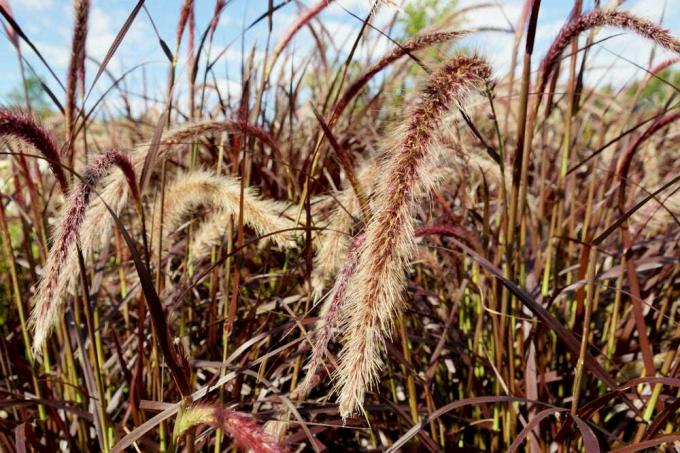
Spring is the best time for planting. Hardy varieties can be planted in the garden from the end of March on a frost-free day. For specimens that are not hardy, you should wait until after the ice saints to plant them. If you would like to cultivate the feather bristle grass in a bucket, it is advisable to wait until mid-May. The plant gets much more cold in pots than in the garden soil. Frost can frostbite even freshly cultivated hardy feather bristlegrasses if they haven't had enough time to set. Therefore, in principle, mid-May is the earliest time for cultivating in tubs.
soil condition
An important criterion for healthy, strong growth concerns the soil conditions. This determines whether there is a sufficient supply and how this ornamental grass thrives. If you stick to the following properties of the soil, the lamp cleaning grass will thank you with a long service life:
- permeable
- Nutritious
- Moderately dry to fresh and without waterlogging
- Preferably slightly sandy or loamy (prevents waterlogging)
- It tolerates low lime content
- pH value: slightly alkaline to slightly acidic
substrate
If the feather bristle grass is planted in a bucket, the bucket soil should also have the properties already mentioned for outdoor planting. Particular attention must be paid to water permeability, since the risk of waterlogging in tubs is significantly higher than in open ground. For this reason, it is advisable to choose a substrate that also has coconut fibers or perlite.

Basically, you can also take conventional potting soil and mix it yourself with coconut fibers, perlite or gravel. Because cheap potting soil in particular tends to compact quickly, the additional material must be extensively and, in particular, evenly incorporated. But even then there is still a higher residual risk, which is why you are better advised to use a high-quality substrate in the long term.
Plant
outdoor planting
Only hardy Pennisetum alopecuroides should be planted outdoors. Since they can take root strongly, frost-sensitive plants are difficult or impossible to plant out in autumn without damage in order to resettle them in winter quarters. Non-hardy feather bristle grasses are therefore not ideal for planting outdoors.
When planting outdoors, proceed as follows:
- Planting hole depth/width: twice the size of the plant ball
- Planting distance: between 60 centimeters and 80 centimeters
- Lay a two centimeter thick layer of gravel or quartz sand from the bottom of the planting hole (drainage)
- Enrich excavated soil with compost or fertilizer
- Spread a few centimeters of soil over the drainage
- Use plant balls so high that there is a distance of at least five to six centimeters from the surface of the earth
- Spread the remaining soil around and on the bale and press down in layers (increases stability)
- Pour generously
tub planting
Pot planting is similar to outdoor planting. Make sure the bucket is big enough and has a drainage hole to allow excess water to drain away. To avoid water stains on terrace or balcony slabs, for example, we recommend using a coaster. Maintain a distance of at least two centimeters between the substrate surface and the edge of the bucket. This will prevent wet soil from spilling over after watering.
repot
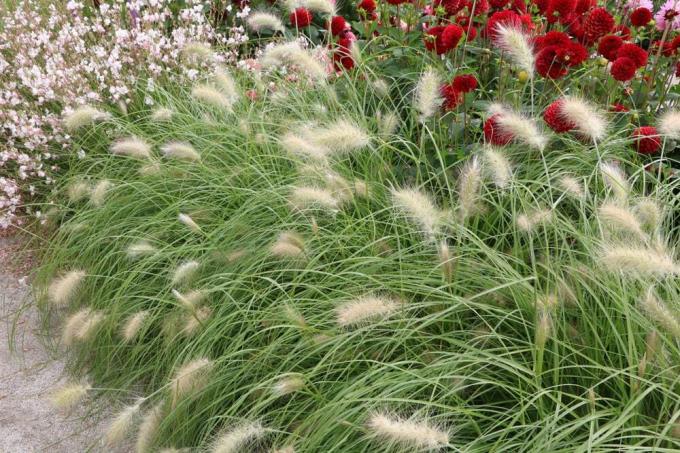
If the Pennisetum alopecuroides is too big for the pot, you will recognize this by the fact that it will stagnate in growth and, in the worst case, even turn brown. As a rule, the roots push their way through the drainage hole. Here is the latest time to repot into a larger bucket. If the ornamental grass is to be restricted in its growth, the roots must be cut so that they have enough space in the old pot again. The substrate should be exchanged for a new, fresh one during the process. Otherwise, repotting in fresh substrate every three to four years is usually sufficient.
Pour
moisture content
The feather bristlegrass likes a moisture content between dry and slightly moist. It can't cope with waterlogging any more than with permanent dryness. For this reason, it is always important to ensure a slight moisture content and to water it regularly. The need for water increases, especially in summer in a sunny/full sun location. Nevertheless, even on the hottest summer days, watering once a day is enough and soaking the soil/substrate well. When cultivating in buckets with a saucer, you must remove the water that has run off after watering so that the ornamental grass does not remain in it and waterlogging occurs.
After planting/cultivating
Freshly planted and cultivated specimens should be kept slightly moist for the first two weeks so that the ornamental grass can settle better. The soil is then allowed to dry out for a short time, but never dry out.
water quality
You should only use well-tempered, soft, lime-free water as irrigation water. Lampbrush grass does not tolerate cold water well. Rainwater or stagnant tap water is best suited as irrigation water for feather bristle grasses.
Fertilize
Lamp cleaner grasses are very frugal when it comes to their nutritional requirements. Fertilizing is not absolutely necessary, but should be done under certain circumstances. This is the case if the Pennisetum alopecuroides has been in the same soil in an outdoor location for a few years or if neighboring plants are drawing a lot of nutrients from the soil. You should then fertilize according to the following instructions:
- Use nutrient-rich compost, blue seed fertilizer or complete liquid fertilizer for green plants and perennials
- Fertilizer time: spring and/or just before the start of flowering in July
- Stop fertilizing after September
- Strictly follow the manufacturer's recommended dose to avoid over-feeding
Cut
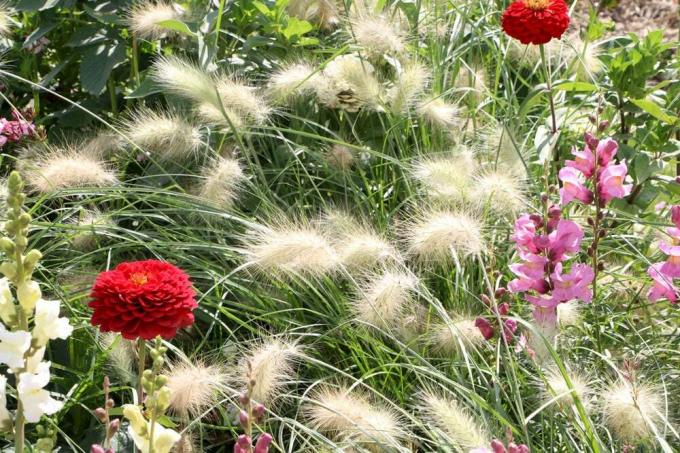
Due to the beautiful, even growth habit, the feather bristle grass does not usually have to be cut, provided it is healthy and has sufficient space in all directions. If it doesn't, and grows too close to neighboring plants, pruning is required. A so-called maintenance cut, in which old, rotten or dried-up parts of the plant are cut off, should be carried out regularly.
When cutting you should consider the following:
- Never cut radically, this weakens the plant
- It is optimal if you limit yourself to cutting the tips of the stalks
- Maximum pruning: up to ten centimeters in length
- Optimal time for pruning: spring after the ice saints
- Remove dried or rotten stalks
- Never prune in the fall as this increases the risk of frostbite and rot
wintering
The correct overwintering of lamp cleaning grasses depends on whether the respective variety is winter-proof. Hardy grasses can remain outdoors, while frost-sensitive plants should move into suitable winter quarters. In the case of hardy feather bristle grasses, it should be taken into account that they only tolerate temperatures well below minus six degrees Celsius. When it gets colder, special precautions protect against frostbite.
For overwintering the ornamental grasses, you should proceed as follows:
- Tie hardy plants together at the latest from six degrees Celsius
- Cover with plant fleece, straw or twigs (especially potted plants and in windy locations)
- Never cut before the start of winter - increases the risk of rotting and frostbite
- Overwinter non-hardy grasses in a frost-free, dark place
- In the case of potted plants, regularly check the substrate for rot and mold and remove if necessary
- Make sure that the soil/substrate does not dry out completely
multiply
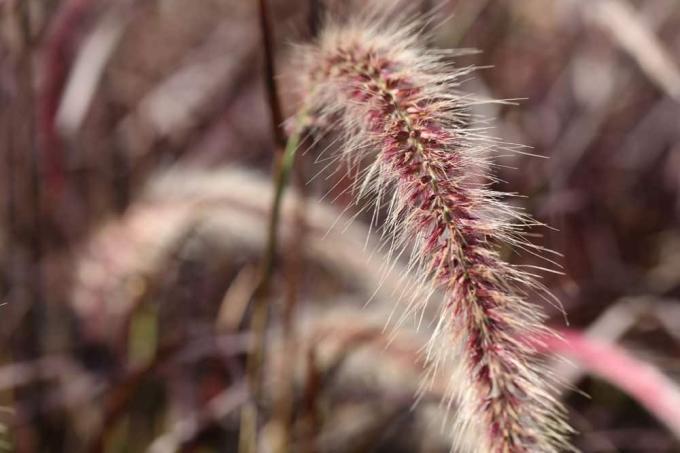
Would you like to have several feather bristle grasses in the garden or on the balcony at low cost? In these cases it is worthwhile to multiply, which can easily be done by dividing. Regular division is recommended, especially for older plants that tend to turn brown or become matted. By dividing the roots, they gain strength and can grow vigorously again.
Proceed as follows when dividing:
- Plant out the root ball in spring after the last frost
- Divide the root ball into two, three or four sections, depending on size and need
- Plant all parts including the "mother plant" in the soil/pot as described under "Plants".
- Water generously and make sure the soil is constantly moist (no waterlogging) for the next two weeks.
Tip:
If an ornamental grass is very sparse, you can give it more volume again by dividing a fuller plant. To do this, simply plant a divided root area directly next to the light specimen, then they will connect quickly and a higher density will result.
diseases and pests
The feather bristlegrass is usually a fairly inconspicuous plant in terms of diseases and pests. Illnesses are mainly due to care errors.
rust
Rust is a fungal disease. The Pucciniales spreads above all on very moist ornamental grasses. It can be recognized by the typical discoloration of the culms, which can appear in yellow or red tones. Spore deposits form. The leaves die off as the fungal infection progresses. Fighting is urgently recommended. In order not to waste time experimenting with possible home remedies, it is advisable to use a fungicide from a specialist shop to kill the fungus as quickly as possible.
rot
If you mean it too well with the watering or if, for example, stalks are bent during an autumn storm, this can be the trigger for rot. The stalks soften and mold can form. Cut off all affected parts of the plant and allow the soil/substrate to dry out.
If the rot occurs in the fall, there isn't much you can do. If you were to cut now, you increase the risk of the rot spreading over a large area. For this reason, you should only limit yourself to drying the soil/substrate and treating additional mold infestation with a fungicide. Pruning is then only done in the spring after the frost. A complete pruning to a height of ten centimeters may be necessary for the ornamental grass to regain its strength.
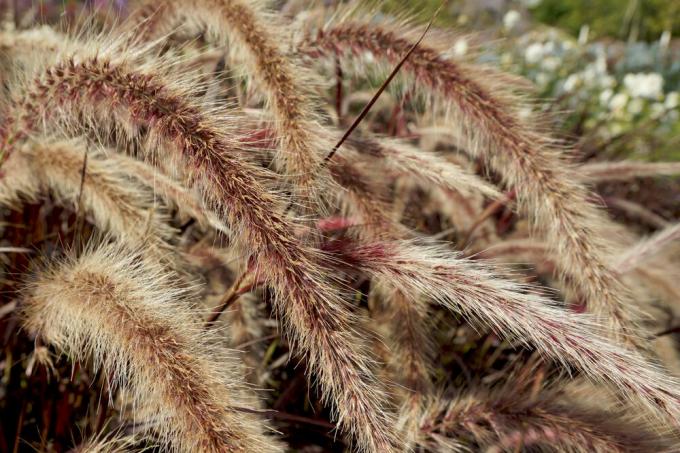
spider mites
Spider mites like dry, warm air. The parasites, which are between 0.25 and 0.8 millimeters in size, can hardly be seen with the naked eye. Depending on the season and host species, they can be pale green, yellow-green, orange, or reddish-brown in color. Clear signs of a spider mite infestation are yellow spots on the grass and white webs that can extend over the entire plant.
Spider mites can be controlled quickly and effectively in the following way in an environmentally friendly and effective manner:
- Give the feather bristle grass a vigorous shower/hosing down
- Wrap the plant completely, and if possible airtight, in translucent plastic wrap
- Leave the ornamental grass wrapped for two to three days
- Then open the slide
- If spider mites are still visible, the process can be repeated
sorts
Pennisetum alopecuroides'compress'
- Australian feather bristlegrass
- Growth height: between 70 and 120 centimeters
- flowers yellowish-brown in late summer
- moderately hardy
Pennisetum alopecuroides'Hamelin'
- Growth height: about 50 centimeters
- brown-red false ears
- early bloomers
- hardy
Pennisetum alopecuroides'Japonicum'
- Japan Pennisetum grass
- Growth height: between 60 and 120 centimeters
- flowers yellow-brownish from late summer to late autumn
- moderately hardy
Pennisetum alopecuroides'Little Bunny'
- Dwarf Pennisetum
- Size between 10 and 30 centimeters
- cylindrical false ears
- narrow habit of leaves and culms
- moderately hardy
Pennisetum alopecuroides'Moudry'
- Growth height: up to 50 centimeters
- lush green foliage
- violet to black panicles
Pennisetum alopecuroides'Weser Uplands'
- Growth height between 40 and 70 centimeters
- Yellow-brown flowers from late summer to autumn
- moderately hardy
 garden editorial
garden editorial I write about everything that interests me in my garden.
Learn more about ornamental grasses
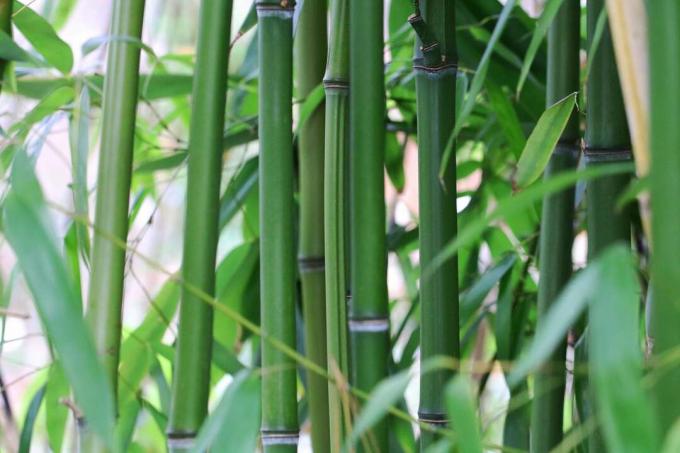
cutting bamboo | When and how to cut back bamboo?
Be it as a hedge, solitaire or ground cover, bamboo can be seen more and more often in home gardens. Because the sweet grass is easy to care for and easy to grow. However, the latter can quickly become a problem if the plants are not pruned regularly.

11 Tips for Cutting Grasses | Tools & Co.
Cutting ornamental grass works best with our tips: From choosing the right tool to right time - we have the most useful tips and tricks for you for the annual grass cut summarized.
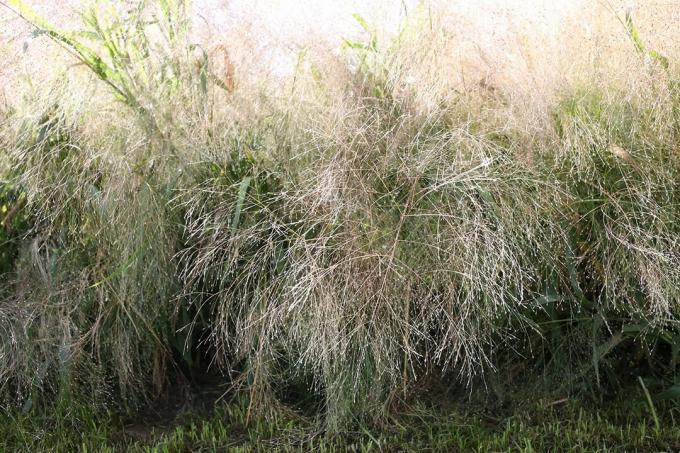
Switchgrass, Panicum virgatum: Care from A – Z
Switchgrass is an upright-growing, clump-forming grass with narrow leaves. The species is considered to be easy to care for and makes few demands on location and soil. Read how to optimally plant and care for Panicum virgatum.

Zebra grass, Miscanthus sinensis 'Strictus': care from A - Z
In botanical jargon, zebra grass is also called Miscanthus sinensis 'Strictus'. The plants can be used wonderfully as privacy screens and are decorative. From care in the tub to overwintering: You can find information on care from A - Z here.

Grow pampas grass from seeds: we explain how
Pampas grass is considered easy to cultivate and can be successfully propagated by breeding. Under controlled conditions in the planter, the germination success is higher than with direct outdoor sowing. The procedures regarding substrate, choice of location and care hardly differ in these variants.
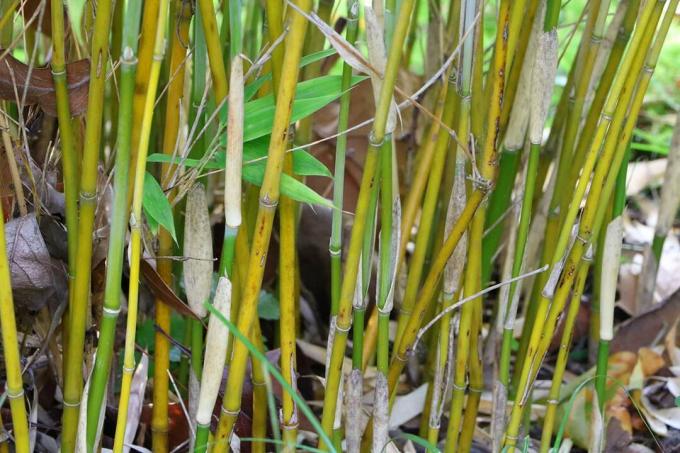
Grasses as a privacy screen: 20 tall grasses
Numerous grasses are ideal as privacy screens! We present the 20 most popular grasses in this article!



